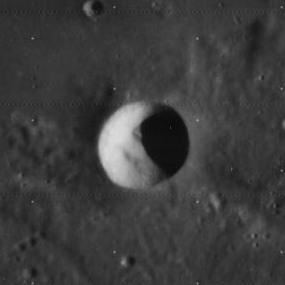
Bancroft is a small, bowl-shaped impact crater located to the southwest of Archimedes on the Mare Imbrium. A wide, shallow depression runs from the rim of Bancroft southeast to the Montes Archimedes. There are some clefts at the edge of the mare to the west and southwest of the crater. Other prominent craters are two small craters nearly to the west named Feuillée and Beer.

Brackett is a small lunar impact crater that lies near the southeast edge of Mare Serenitatis. The crater is named after American physicist Frederick Sumner Brackett. The crater has been covered by lava flow, leaving only a ring-shaped trace in the surrounding lunar mare. This crater is best observed under oblique illumination, as it is otherwise difficult to find. The southern rim is almost contacting a rille system named the Rimae Plinius.

Artsimovich is a small lunar impact crater located in the western Mare Imbrium of the Earth's Moon. This is a circular crater forming a cup-shaped excavation in the surface of the lunar mare. It is named after Soviet physicist Lev A. Artsimovich. To the east is the crater Diophantus and to the northeast lies Delisle. Less than 20 kilometers to the north-northeast is the tiny Fedorov. This crater was identified as Diophantus A before being named by the International Astronomical Union.

Aryabhata, named after Indian astronomer Aryabhata, is the remnant of a lunar impact crater located in the eastern Mare Tranquillitatis. The crater has been almost submerged by lava-flow, and now only an arc-shaped ridge formed from the eastern half of the rim remains above the lunar mare. This crater was previously identified as Maskelyne E before being named by the IAU in 1979. Maskelyne itself is to the southwest.

Caventou is a tiny lunar impact crater located in the western part of the Mare Imbrium. It is a circular, cup-shaped formation surrounded by the lunar mare. It was named after French chemist Joseph B. Caventou in 1976. Prior to that, it had the designation La Hire D, being associated with the mountain Mons La Hire to the southeast.
Abetti is a lunar impact crater that has been completely submerged by mare lavas. It forms a 'ghost crater' in the surface, showing only a curved rise where the rim is located. Abetti is located near the southeast edge of Mare Serenitatis, to the west of the Mons Argaeus. This crater is generally visible only at low angles of illumination. It is named after two Italian astronomers, Antonio Abetti and his son Giorgio.
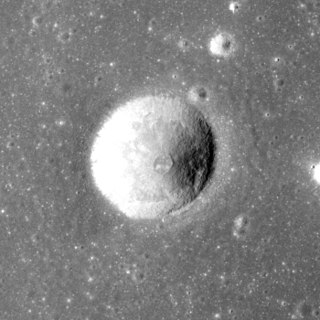
Borel is a tiny lunar impact crater located in the southeast part of Mare Serenitatis. It was named after French mathematician Émile Borel. To the northeast is the crater Le Monnier and to the southeast is the crater Abetti. Borel was previously identified as Le Monnier C.

Fahrenheit is a tiny lunar impact crater located in the southeast part of the Mare Crisium. This area of the surface is nearly devoid of impact features of interest. To the east are the Dorsa Harker wrinkle ridges, and beyond them is Promontorium Agarum at the edge of the mare. The landing site of the Soviet Luna 24 probe is located about 15 kilometers to the southeast.

Abbot is a small lunar impact crater that lies on the rugged ground between the Mare Fecunditatis in the south and west, and the Mare Crisium to the north. It is a circular crater with a cup-shaped interior. The inner walls slope downward to the midpoint, and no impacts of significant mark the interior or the rim.

C. Herschel is a small lunar impact crater that lies on the western part of Mare Imbrium. It is named after British astronomer Caroline Herschel. It is a circular, bowl-shaped formation that has not undergone significant erosion. The interior floor has the same low albedo as the surrounding lunar mare. To the south-southwest is the similar crater Heis. C. Herschel lies on a wrinkle ridge of the lunar mare named the Dorsum Heim.

Crile is a tiny lunar impact crater. It is roughly circular and cup-shaped, with interior walls that slope down to the midpoint. The crater lies in the Palus Somni, between the Mare Crisium to the east and Mare Tranquillitatis to the west.
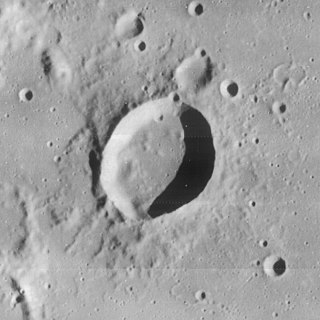
Clausius is a lunar impact crater that is located in the southwest part of the Moon, in the small lunar mare designated Lacus Excellentiae. It is completely enclosed by mare material, although the tiny satellite crater Clausius A lies just to the north. The rim of Clausius is low and sharp, with a slightly oval shape that is longer in the north-south direction. The interior floor has been flooded by basaltic lava, and appears level and featureless with a darker surface that matches the mare surface that surrounds the crater exterior.
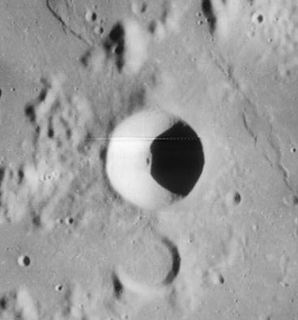
Darney is a small lunar impact crater that is located on the region of the Moon where the Mare Nubium joins the Oceanus Procellarum. It was named after French astronomer Maurice Darney. To the south is the lava-flooded crater Lubiniezky. The southern rim of Darney is attached to a series of low ridges that extend to the southwest.

Feuillée is a small lunar impact crater in the eastern part of the Mare Imbrium. It was named after French natural scientist Louis Feuillée. It lies less than a half crater diameter to the northwest of Beer, and the two formations form a nearly matched pair. To the west is the small but prominent crater Timocharis.

Fabbroni is a small lunar impact crater that lies along the northern edge of the Mare Tranquillitatis, at the eastern edge of the gap where the lunar mare joins Mare Serenitatis to the north. To the southeast is the crater Vitruvius.

Eckert is a tiny, isolated lunar impact crater in the northern part of the Mare Crisium. This crater forms a circular pit in the dark surface of the surrounding lunar mare. Just to the west is a wrinkle ridge in the mare surface, a feature that is prominent only under oblique lighting from the Sun. The nearest craters of note are Peirce to the west-northwest, and Picard to the southwest. Both of these craters lie in the Mare Crisium basin.

Courtney is a tiny lunar impact crater on the Mare Imbrium, a lunar mare in the northwest quadrant of the Moon. It lies about two crater diameters to the northwest of Euler, in an otherwise isolated stretch of the mare. The dark surface in this region is marked by Euler's ray material. The name is an English male name.
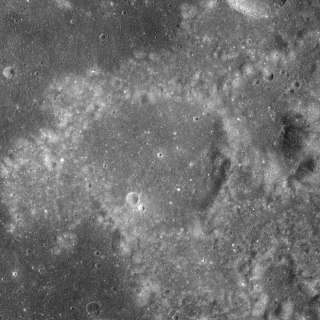
File: Franz is a small lunar impact crater identified during the Apollo mission in August 1971 and located along the eastern edge of the Sinus Amoris, a bay that forms a northern extension to the Mare Tranquillitatis. Its diameter is 25 km. It was named after German astronomer Julius Heinrich Franz. It lies to the southwest of the prominent crater Macrobius. To the north is the smaller Carmichael, and to the northwest is the diminutive Theophrastus.

Chalonge is a lunar impact crater that is located on the far side of the Moon. It lies to the southwest of the larger crater Lewis, in the outer skirt of ejecta that surrounds the Mare Orientale impact basin. To the southeast are the Montes Cordillera, a ring of mountains that encircle the Mare Orientale formation.
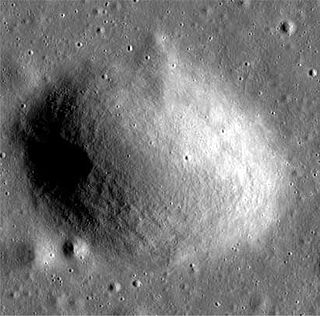
Donna is a tiny lunar crater on the near side of the Moon. Its name is an Italian female given name, and does not refer to a specific person. It is located in the eastern half of the Mare Tranquillitatis, at the summit of the lunar dome Omega (ω) Cauchy. As such domes are thought to be volcanic in nature, it appears likely that this crater was created by an eruption. This is in contrast to most lunar craters, which are now believed to be created by impacts. This crater is sufficiently small that it requires a large telescope to resolve.






















